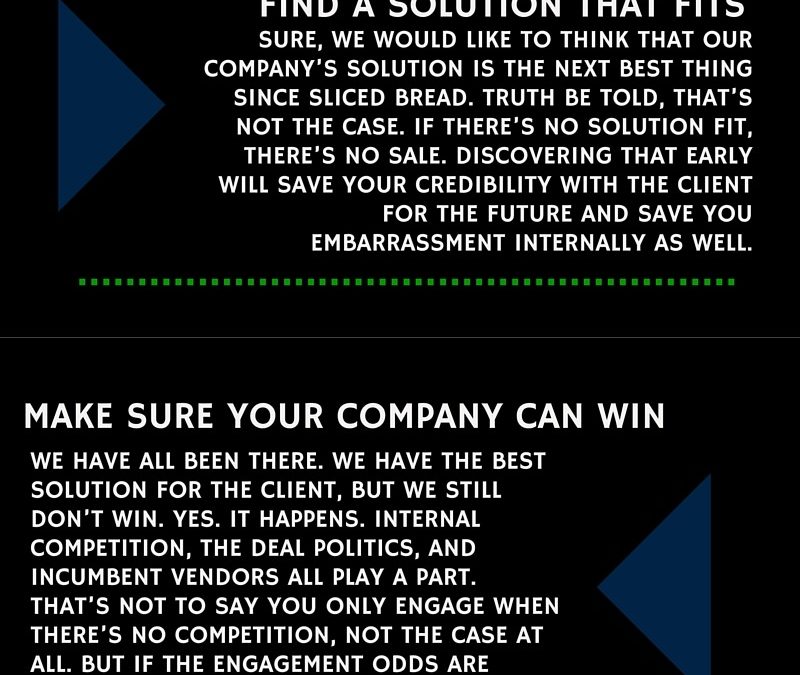
by Elizabeth Hines | Oct 12, 2015 | Blog, Logistics, Strategy, Supply Chain

There are organizations that sell products and there are organizations that sell solutions. To be sure, both can be successful as long as products are being sold as products and solutions like solutions. The difference is that the product sale is really a commodity sale. Commodities come with an “each” price or a “per pound” pricing matrix, etc. It usually is a short or shortened sales cycle and negotiations revolve around the total price and your typical supplier performance metrics. The solution sale is much different. This sale is one that requires client discovery, isolation of unique client pain points (that only your solution can address effectively), and being able to drive distinct value for the client, and in turn, for your organization. This sales effort is highly specialized and requires selling time (sales cycle) that is much more detailed than a product sale. That being the case, you need to be sure that your close rates are high enough to justify the work load and sales cycle needed. You also need to be sure that the deals you close have a deal size that reflect the sales effort and cycle time (said another way, is the deal worth winning?)
If your sales team thrives on creating value for their customers far beyond ‘supplying’ their ‘product’ at the best price, check out our other solution selling tips below.

Fronetics Strategic Advisors is a leading management consulting firm. Our firm works with companies to identify and execute strategies for growth and value creation.
We advise and work with companies on their most critical issues and opportunities: strategy, marketing, organization, talent acquisition, performance management, and M&A support.
We have deep expertise and a proven track record in a broad range of industries including: supply chain, real estate, software, and logistics.

by Elizabeth Hines | Oct 8, 2015 | Blog, Strategy, Talent

Hiring someone who says he or she is not a team player sounds like a risky proposition, right? Few employers are, after all, searching for renegade employees or stubborn loners who refuse to interact with co-workers. But what if it actually turned out to be a good strategy? Researchers at the University of Tuebingen set out to examine the effects on applicant pools by stressing the need for teamwork in job ads. The conclusion of the study puts it like this: “Given the evidence of a possible downside, it is recommended that firms should never look for team players just because ‘everyone else is doing so.'”
The study analyzed survey data from 1,300 college students who had been asked to evaluate a number of job postings that outlined various requirements, including whether the applicant should be a team player or an independent task-oriented self-starter. Interestingly, what researchers found was that although the ads did indeed attract applicants who considered their teamwork skills to be a primary asset, they also discouraged people whose qualifications matched the job description with the exception of one criterion: social skills. As a result, the employer missed out on technically skilled or task-oriented candidates who took themselves out of the running before the race even began. The study went on:
“…considering that organizations always need employees with high task-related skills, but that they may not always need team players, they should carefully consider when the requirement for teamwork skills is listed in their job advertisements—because there is a downside to looking for team players.”
For organizations that truly need employees with an aptitude for collegial collaboration, the study shows ads that stress the importance of possessing teamwork skills do what they were intended to accomplish. But in other cases, where teamwork takes a backseat to specific talents or technical skills, the employer is likely to end up with a smaller pool of applicants than if that routine phrase had been left out of the job requirements.
People who don’t cite social acumen among their list of skills may not thrive at “water-cooler conversations” or rush to plan the next company outing, but they know how to get the job done and they do it well. If teamwork is irrelevant to their job description, isn’t that all we really need?
Fronetics Strategic Advisors is a leading management consulting firm. Our firm works with companies to identify and execute strategies for growth and value creation.
We advise and work with companies on their most critical issues and opportunities: strategy, marketing, organization, talent acquisition, performance management, and M&A support.
We have deep expertise and a proven track record in a broad range of industries including: supply chain, real estate, software, and logistics.

by Elizabeth Hines | Sep 29, 2015 | Blog, Strategy, Supply Chain

Across the globe, many industries are seeing aftermarket services outperforming the general market. We can point to many reasons for this occurrence: the tendency for aftermarket services to remain stable in trying times, buyers remaining flush with cash, competition among buyers driving valuations higher with historically low pricing, and buyers making strategic purchases to focus on supplementing growth of their own businesses by acquisition. Regardless of the reason why, investors have become increasingly interested in the aftermarket sector and the implications of this are significant. These deals have the power to change the market, alter customer base, and challenge companies’ competitive positions.
This is a far different story from just four years ago when an article ran in the New York Times Dealbook section by Stephen Davidoff titled, “For Private Equity, Fewer Deals in Leaner Times.” Davidoff’s article listed the primary forces that drove turbulence in that marketplace. At that time, there were too few “good” merger and acquisition opportunities, “deals” were greatly overpriced, and there were fewer sellers in the market (and the ones that were making themselves available are being snatched up by strategic buyers). But what was most interesting, and what I’ve been tracking since then, was that the private equity industry’s biggest problem was having too much money to invest. You read that correctly — too much money to invest.
When I read the phrase “too much money to invest,” it got me thinking about the hi-tech aftermarket services industry and how underserved it had been from a private equity standpoint. In the hi-tech aftermarket industry in particular, there were, and still are, plenty of really good platform companies with strong footholds in service or geographic niches that truly make them unique and valuable. What they typically lack, though, are the funds and guidance that a responsible and possibly patient private equity firm can offer. Not only do these platform companies in the high-tech aftermarket services space make for attractive investments, but it seems to me that the financials in these “niche companies” are there to support private equity interest, as well. These businesses typically have gross margins in the 35-40 percent range and net margins that are really attractive when compared with the overall hi-tech space. Combining or rolling up companies with expertise in adjacent service and/or geographic areas into a “newco” with broader reach and a deeper service offering will surely deliver financial results that private equity would consider better than not investing. The high-tech aftermarket services space is a fractionalized marketplace with accomplished participants, quality customers, and better than traditional financials when compared with the overall industry averages. And private equity firms have started to realize these points. To this, I say bravo, but there’s still lots of money that needs to be put to work.

by Elizabeth Hines | Sep 14, 2015 | Blog, Content Marketing, Marketing, Strategy

Selling certainly isn’t like it used to be. Take the requisite childhood lemonade stand, for example. Every summer thousands of entrepreneurial youths take to their neighborhood streets with pitchers of homemade lemonade to offer passers-by a cool drink for a small fee. For decades now these business startups and their transactions have generally been straight-forward. Recently, though, the owners and operators of these businesses, almost all children, have faced increasing complexity in their business environment. Local authorities have been cracking down on lemonade stands without proper city permits or food handling licenses. Potential customers have grown more mindful of product ingredients. These new idiosyncrasies have everyone wondering, “When did selling become so complex?”
Successful companies have adapted to these new selling pressures by placing emphasis on a strategic selling process. MHI Global suggests that these strategic selling processes “significantly improves the odds of [a business] winning complex sales opportunities by defining a process for pursuing sales opportunities and establishing common criteria for allocating resources.” Those companies are then able to determine when to walk away from resource-intensive deals with a low probability of success, giving salespeople the time and energy to focus on the opportunities most likely to become profitable, long-term customers.
There’s little doubt that the role of strategic selling is one of the toughest in any organization. It’s also one of the most expensive line items for most companies – so getting it right is important. There are a lot of great strategic sales teams out there, to be sure. But there’s an equal amount of selling teams that could use some advice.
Here are five ways to optimize your strategic sales teams and, in turn, increase their revenue-producing effectiveness.
Devise a Process
Strategic selling is a process. Like any process, discipline and milestones mark the way. Only through uniform use, iteration, and formal improvement will your organization, the sales team, and the salesperson become more effective. I don’t care what the process looks like…yet. Get a process that everyone can track inside your organization and stick to it. No loose cannons or end around players….they devalue the process.
Refine Your Process
Once you have an established process, take the time to refine it. The most successful strategic selling processes include some iteration of the following items:
- Assessing the selling opportunity
- Developing a competitive strategy
- Identifying the key decision makers and their motives/agendas
- An action plan
- Sales plan testing and improvement
- An organization implementation process
Create a Compelling Event
If your sales process relies solely on responding to RFPs, you are not strategically selling….you are responding to opportunities that every qualified organization will see and compete for. Create a compelling event inside your target customer. The easiest sale is the one that your competitors never knew about in the first place. Creating a sense of urgency and need inside a customer is hard work and takes time, but that’s what makes it valuable to your client and your organization. Knowing your customers’ needs and how your solution fits makes you more valuable than a traditional “RFP responder”. Be there first, be relevant, and be action oriented and your customers will rely on your solutions more often.
Make the Most of Your Resources
Time is money and both are scarce resources. Make the most of these precious resources and never fall in love with an opportunity unless it meets the following criteria. If it fits, engage fully and engage to win. No half efforts. Ask yourself these questions:
- Is there a true opportunity that has been clearly identified and agreed to within your customer’s organization? Said another way, is there a “compelling event” as mentioned above that everyone involved is aligned around?
- Can you compete to win? Does your solution or unique business differentiator align to produce customer benefit? Can it be aligned?
- Can you win? Are there any commercial obstacles that would stand in the way to your winning? These can be politically driven, relationship driven, or even solution driven.
- Is the opportunity worth winning? Does it have the desired ROI for the investment of selling resources? Does it contain enough profit to engage your organization? Is it too risky a fit (a force fit to your solution) or does the risk and reward balance? Can your customer pay for the service? Have they allocated funds?
Avoid ‘Work for Free’ Promotions
Stay away from “free trials” or “free pilot” engagements. In fact, run from them. If your customer is headed down that path, revisit number four above. It could be that they do not completely understand your solution and how it fits, or simply that they have no funds to undertake the engagement. In either case, time is money and it’s time to move on.
Make no mistake, the strategies listed above are not easy to instill in a sales organization. But by doing so, true opportunities will increase, they will have greater value, and your chances of success will soar. No hard work goes unrewarded.

by Elizabeth Hines | Sep 7, 2015 | Blog, Strategy, Supply Chain

Multi-channel distribution is likely to fuel the demand for on-demand packaging as companies continue their search for more cost-effective solutions.
Only 7% of companies are making their boxes on demand. However, that figure is set to grow quickly. The explosive rise of e-commerce and all the uncertainties it entails in terms of order fulfillment will likely prompt a growing number of companies, especially those serving multiple sales channels, to seek the answers in on-demand packaging.
The potential savings of always getting the right-sized box at just the right time should speak to all those multi-channel distributors. In a Peerless Research study, distributors were asked to name the areas where fulfillment costs have gone up. The three most popular answers were transportation, labor, and packaging and materials.
A corporate manager at an e-commerce business said about trends in packaging automation, “We are able to consolidate multiple orders from one customer into as few boxes as possible. This saves on time and shipping costs.”
That study talks of the “ripple effect” felt throughout the supply chain as packaging optimization drives down the number of cases on a pallet, as well as storage space requirements and shipping costs, and ultimately has the power to increase a company’s sustainability rating.
In numbers, some of the advantages cited by on-demand packaging proponents include:
- A 28% reduction in the quantity of corrugate
- An 80-90% reduction in filling material
- Savings of 20-35% over conventional supply chains
- A 75% reduction in footprint required by two laborers to pack dunnage, seal, and label a box
Packsize, one of several companies behind the new automated technology, says it actually takes less time to make packaging on demand than going the conventional route of locating and moving packaging purchased from a vendor. Stockouts and obsolete inventory also become relics of the past when boxes can be made minutes before they are needed. In an industry chasing next-day or even same-day delivery, any gain in timely execution counts as a victory.
Though 80% of the 322 top materials handling, logistics, and supply chain managers surveyed by Peerless still purchase and store their corrugated boxes, the trend is pointing in favor of the new solutions. Industry familiarity with on-demand packaging is increasing while the desire for new packaging solutions continues to grow. “We currently have to order in advance custom size boxes for upcoming orders, and it would be better to make them on the fly, adapting to changes,” an engineering manager said. “We are considering some form of on-demand packaging to prevent the storage of cartons,” another said. “We can use the space better.”
It all sounds promising, but is it the way of the future?
Fronetics Strategic Advisors is a leading management consulting firm. Our firm works with companies to identify and execute strategies for growth and value creation.
Whether it is a wholesale food distributor seeking guidance on how to define and execute corporate strategy; a telematics firm needing high quality content on a consistent basis; a real estate firm looking for a marketing partner; or a supply chain firm in need of interim management, our clients rely on Fronetics to help them navigate through critical junctures, meet their toughest challenges, and take advantage of opportunities. We deliver high-impact results.
We advise and work with companies on their most critical issues and opportunities: strategy, marketing, organization, talent acquisition, performance management, and M&A support.
We have deep expertise and a proven track record in a broad range of industries including: supply chain, real estate, software, and logistics.










